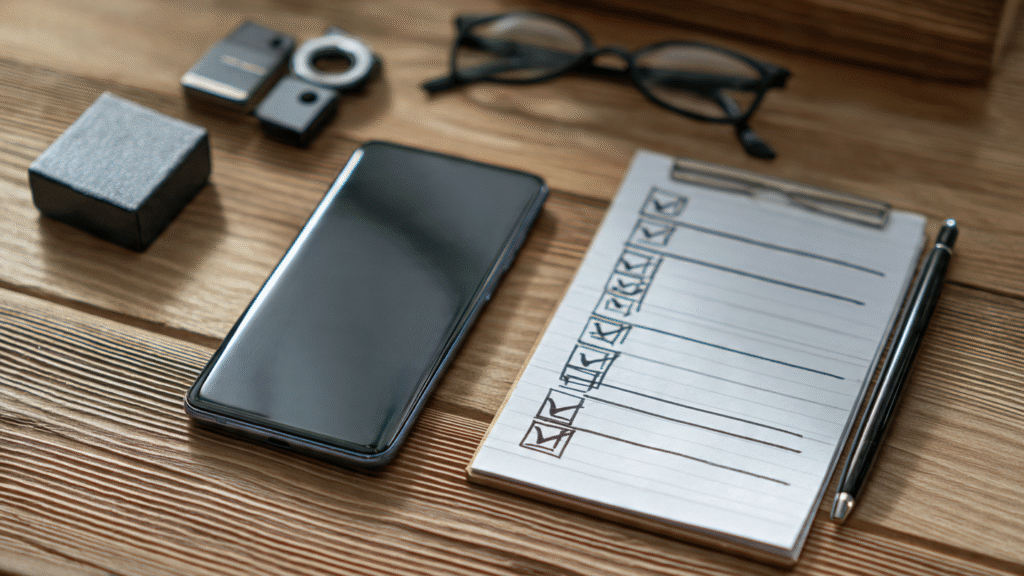Buying a used smartphone can save you a lot of money, but it also comes with risks if you don’t know what to look for. Whether purchasing from a friend, an online marketplace, or a local shop, it’s important to check the phone thoroughly before paying.
In this guide, we’ll cover everything you need to check when buying a used smartphone in 2025 — from physical inspection to software verification — so you can avoid scams and get the best deal.

1. Physical Condition of the Phone
- Screen: Look for cracks, scratches, or dead pixels. Test touch responsiveness across the whole screen.
- Body/Frame: Check for dents, bends, or water damage signs.
- Buttons & Ports: Power button, volume keys, SIM tray, headphone jack, and charging port should work smoothly.
- Camera Lenses: Inspect for scratches or dust inside the lens.
2. Battery Health
- Ask for the battery health percentage (iPhones display it in settings; Android may need third-party apps).
- A healthy battery should be above 80% capacity for reliable performance.
- If the battery drains quickly or the phone overheats, you may need a replacement.
3. Screen Quality and Touch Response
- Open a white background to check for screen burn-in, dead pixels, or discoloration.
- Test multi-touch gestures like zoom, scrolling, and swiping.
- Increase brightness to maximum to ensure backlight uniformity.
4. IMEI/Serial Number Verification
- Dial
*#06#to check the IMEI. - Verify the number on the manufacturer’s website to ensure the phone is genuine.
- Check if the IMEI is blacklisted or reported stolen (use free online IMEI check tools).
5. Network and Connectivity
- Insert your SIM card to confirm:
- The phone connects to your carrier.
- Calls, texts, and mobile data work properly.
- Test Wi-Fi, Bluetooth, GPS, and NFC functions.
6. Storage and Performance
- Go to settings to confirm advertised storage size.
- Test performance by opening multiple apps, switching tasks, and running heavy apps (like YouTube or a game).
- Check for lag, freezing, or unusual slowdowns.
7. Software and Updates
- Confirm the phone is running the latest stable software version.
- Check if the manufacturer still provides updates and security patches.
- Factory reset the phone to ensure it’s free from malware or old user data.
8. Camera and Audio Quality
- Test front and rear cameras for clarity, autofocus, and low-light performance.
- Record a short video to check microphone quality.
- Play music or video to test speakers.
- Connect headphones to confirm audio jack or Bluetooth functionality.
9. Accessories and Warranty
- Ask for the original box, charger, and accessories if available.
- Check if the phone still has an active warranty or insurance coverage.
- Beware of counterfeit chargers or unsafe accessories.
10. Price Comparison
- Compare the price of the used smartphone with new models and other sellers.
- Avoid deals that seem “too good to be true” — they usually are.
Red Flags to Avoid
- Seller refusing to provide IMEI/serial number.
- Phone not performing a factory reset.
- Unusual overheating or slow charging.
- No return/refund policy from online sellers.
FAQs: What to Check When Buying a Used Smartphone
How do I know if a used phone is stolen?
Check the IMEI number on an official blacklist database. If it shows as lost/stolen, don’t buy it.
Is it safe to buy a refurbished phone?
Yes, if purchased from trusted sellers or certified programs. Refurbished phones are tested and usually come with a short warranty.
What’s better: buying from a private seller or a store?
Stores may offer warranties and tested devices, while private sellers can be cheaper but riskier.
How much should I pay for a used smartphone?
Prices depend on model, condition, and age. Generally, aim for 30–50% less than the cost of a new one.
Conclusion: Smart Tips for Buying a Used Smartphone
Buying a used smartphone in 2025 is a smart way to save money, but only if you check it thoroughly before making a purchase. From battery health and screen quality to IMEI verification and accessories, following this checklist ensures you get a safe and reliable device.
👉 Always buy from trusted sources and never skip the IMEI check.
Disclaimer: This article is for informational purposes only. Prices, warranty policies, and phone conditions may vary. Always verify details before finalizing your purchase.